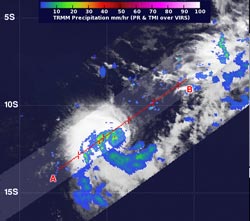NASA Sees Strength in Newborn Tropical Cyclone Emang

NASA's TRMM satellite captured rainfall rates in Tropical Storm Emang on Jan. 13 at 0404 UTC. Moderate (green) and heavy rainfall (red) was occurring around the center of circulation, where rainfall rates ranged from 30 mm (1.18 inches) to 50 mm (2 inches) per hour. Credit: NASA/SSAI Hal Pierce<br>
NASA's Tropical Rainfall Measuring Mission (TRMM) satellite captured rainfall rates in Tropical Storm Narelle on Jan. 13 at 0907 UTC (5:07 a.m. EST). Moderate and heavy rainfall was occurring around the center of circulation, where rainfall rates ranged from 30 mm (1.18 inches) to 50 mm (2 inches) per hour. That heavy rainfall is a sign that there is strong convection occurring within the storm, and forecasters at the Joint Typhoon Warning Center expect the storm will consolidate and organize more over the coming week.
On Monday, Jan. 14, at 0900 UTC (4 a.m. EST), Emang's maximum sustained winds were near 35 knots (40 mph/64.8 kph). Emang's center moved near 12.5 south latitude and 79.4 east longitude, about 500 nautical miles (575.4 miles/ 926 km) southeast of Diego Garcia. Emang was moving to the southwest at just 3 knots (3.4 mph/5.5 kph). Emang is located in is a weak steering environment. It is moving slowly under the influence of a building subtropical ridge (elongated area) of high pressure located to the south of the storm.
Monday's satellite data showed that the low-level center had now become fully exposed to outside winds, and there were shallow bands of thunderstorms around the northwestern edge of the storm. Emang is currently being battered with moderate (up to 20 knots/23 mph/37 kph) vertical wind shear.
Forecasters at the Joint Typhoon Warning Center expect improvements in environmental conditions which will improve the storm's organization. Emang is expected to slowly intensify over the next couple of days as it travels over open ocean. By the end of the week, Emang is expected to reach peak intensity as a cyclone of 65 knots (74.8 mph/120.4 kph).
Emang is currently not a threat to any land areas.
Text Credit: Rob Gutro
NASA's Goddard Space Flight Center, Greenbelt, Md.
Media Contact
All latest news from the category: Earth Sciences
Earth Sciences (also referred to as Geosciences), which deals with basic issues surrounding our planet, plays a vital role in the area of energy and raw materials supply.
Earth Sciences comprises subjects such as geology, geography, geological informatics, paleontology, mineralogy, petrography, crystallography, geophysics, geodesy, glaciology, cartography, photogrammetry, meteorology and seismology, early-warning systems, earthquake research and polar research.
Newest articles

Properties of new materials for microchips
… can now be measured well. Reseachers of Delft University of Technology demonstrated measuring performance properties of ultrathin silicon membranes. Making ever smaller and more powerful chips requires new ultrathin…

Floating solar’s potential
… to support sustainable development by addressing climate, water, and energy goals holistically. A new study published this week in Nature Energy raises the potential for floating solar photovoltaics (FPV)…

Skyrmions move at record speeds
… a step towards the computing of the future. An international research team led by scientists from the CNRS1 has discovered that the magnetic nanobubbles2 known as skyrmions can be…




















